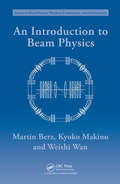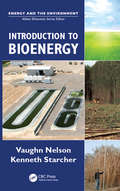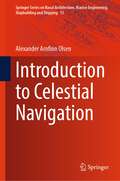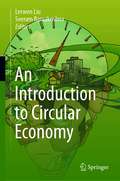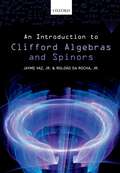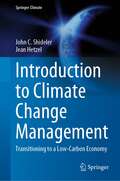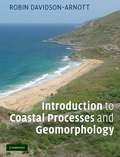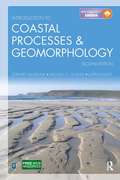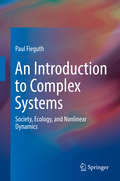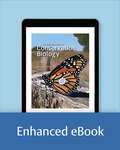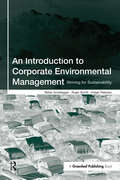- Table View
- List View
Introduction to Bayesian Statistics
by Karl-Rudolf KochThis book presents Bayes’ theorem, the estimation of unknown parameters, the determination of confidence regions and the derivation of tests of hypotheses for the unknown parameters. It does so in a simple manner that is easy to comprehend. The book compares traditional and Bayesian methods with the rules of probability presented in a logical way allowing an intuitive understanding of random variables and their probability distributions to be formed.
An Introduction to Beam Physics
by Martin Berz Kyoko Makino Weishi WanThe field of beam physics touches many areas of physics, engineering, and the sciences. In general terms, beams describe ensembles of particles with initial conditions similar enough to be treated together as a group so that the motion is a weakly nonlinear perturbation of a chosen reference particle. Particle beams are used in a variety of areas,
Introduction to Bioenergy
by Vaughn C. Nelson Kenneth L. StarcherExplore a Major Component of Renewable Energy Introduction to Bioenergy takes a look at energy from biomass (thermal energy, power, liquid fuels, and biogas) and envisions a sustainable future fueled by renewable energy. From production to conversion to heat, power, and biofuel, this book breaks down the science of bioenergy and explains the major processes for its production, conversion, and use. Covers Solar Energy, Bioenergy, and Biomass Resources The book begins with an introduction to solar energy (the source of bioenergy) and then moves on to describe bioenergy, biomass, chemical conversion, and the renewable energy processes involved. The authors cover measurement energy parameters, analysis of data, and the prediction of energy production for different bio products. They also consider the institutional, environmental, and economic concerns surrounding bioenergy. An all-inclusive resource covering a rapidly-advancing field, this book: Explores the impact of climate change and global warming on the production of biomass Describes the positive and negative effects of biomass production on ecosystems and biodiversity Illustrates the use of biomass for the production of electricity Considers the replacement of fossil fuels with biofuels, biofuel production, and emerging technologies Addresses institutional and environmental issues relevant to bioenergy Discusses factors impacting the economic feasibility of renewable energy systems Introduction to Bioenergy defines major processes for the production, conversion, and use of bioenergy. A book suitable for coursework or self-study, this essential work serves students and practicing professionals in the renewable energy, environmental science, agriculture engineering, and biology fields.
Introduction to Bioenergy
by Vaughn C. Nelson Kenneth L. StarcherExplore a Major Component of Renewable Energy Introduction to Bioenergy takes a look at energy from biomass (thermal energy, power, liquid fuels, and biogas) and envisions a sustainable future fueled by renewable energy. From production to conversion to heat, power, and biofuel, this book breaks down the science of bioenergy and explains the major processes for its production, conversion, and use. Covers Solar Energy, Bioenergy, and Biomass Resources The book begins with an introduction to solar energy (the source of bioenergy) and then moves on to describe bioenergy, biomass, chemical conversion, and the renewable energy processes involved. The authors cover measurement energy parameters, analysis of data, and the prediction of energy production for different bio products. They also consider the institutional, environmental, and economic concerns surrounding bioenergy. An all-inclusive resource covering a rapidly-advancing field, this book: Explores the impact of climate change and global warming on the production of biomass Describes the positive and negative effects of biomass production on ecosystems and biodiversity Illustrates the use of biomass for the production of electricity Considers the replacement of fossil fuels with biofuels, biofuel production, and emerging technologies Addresses institutional and environmental issues relevant to bioenergy Discusses factors impacting the economic feasibility of renewable energy systems Introduction to Bioenergy defines major processes for the production, conversion, and use of bioenergy. A book suitable for coursework or self-study, this essential work serves students and practicing professionals in the renewable energy, environmental science, agriculture engineering, and biology fields.
An Introduction to Boundary Layer Meteorology (Atmospheric and Oceanographic Sciences Library #13)
by Roland B. StullPart of the excitement in boundary-layer meteorology is the challenge associated with turbulent flow - one of the unsolved problems in classical physics. An additional attraction of the filed is the rich diversity of topics and research methods that are collected under the umbrella-term of boundary-layer meteorology. The flavor of the challenges and the excitement associated with the study of the atmospheric boundary layer are captured in this textbook. Fundamental concepts and mathematics are presented prior to their use, physical interpretations of the terms in equations are given, sample data are shown, examples are solved, and exercises are included. The work should also be considered as a major reference and as a review of the literature, since it includes tables of parameterizatlons, procedures, filed experiments, useful constants, and graphs of various phenomena under a variety of conditions. It is assumed that the work will be used at the beginning graduate level for students with an undergraduate background in meteorology, but the author envisions, and has catered for, a heterogeneity in the background and experience of his readers.
Introduction to Celestial Navigation (Springer Series on Naval Architecture, Marine Engineering, Shipbuilding and Shipping #15)
by Alexander Arnfinn OlsenThis book focuses on Coastal and Ocean Navigation with an emphasis on celestial navigation techniques as a ‘back up’ in the event digital technologies fail.It deals with the main themes and principles of celestial navigation (including time). It covers the syllabus for deck officers working towards the Officer of the Watch (OOW) certificate of competence (COC) awarded by the Maritime and Coastguard Agency (MCA), and for Royal Navy navigation officers working towards achieving the equivalent Navigational Watch Certificate (NWC). The NWC is equivalent to the certificate awarded by the MCA to OOWs in the Merchant Service under the international Standardisation of Training, Certification and Watchkeeping (STCW) agreements. The detailed theory of celestial navigation is provided.
An Introduction to Circular Economy
by Seeram Ramakrishna Lerwen LiuThis book is purposefully styled as an introductory textbook on circular economy (CE) for the benefit of educators and students of universities. It provides comprehensive knowledge exemplified by practices from policy, education, R&D, innovation, design, production, waste management, business and financing around the world. The book covers sectors such as agriculture/food, packaging materials, build environment, textile, energy, and mobility to inspire the growth of circular business transformation. It aims to stimulate action among different stakeholders to drive CE transformation. It elaborates critical driving forces of CE including digital technologies; restorative innovations; business opportunities & sustainable business model; financing instruments, regulation & assessment and experiential education programs. It connects a CE transformation for reaching the SDGs2030 and highlights youth leadership and entrepreneurship at all levels in driving the sustainability transformation.
Introduction to Clay Minerals: Chemistry, origins, uses and environmental significance
by VeldeIntroduction to Clay Minerals is designed to give a detailed, concise and clear introduction to clay mineralogy. Using the information presented here, one should be able to understand clays and their mineralogy, their uses and importance in modern life.
An Introduction to Clifford Algebras and Spinors
by Jayme Vaz, Jr. Roldão da Rocha, Jr.This text explores how Clifford algebras and spinors have been sparking a collaboration and bridging a gap between Physics and Mathematics. This collaboration has been the consequence of a growing awareness of the importance of algebraic and geometric properties in many physical phenomena, and of the discovery of common ground through various touch points: relating Clifford algebras and the arising geometry to so-called spinors, and to their three definitions (both from the mathematical and physical viewpoint). The main point of contact are the representations of Clifford algebras and the periodicity theorems. Clifford algebras also constitute a highly intuitive formalism, having an intimate relationship to quantum field theory. The text strives to seamlessly combine these various viewpoints and is devoted to a wider audience of both physicists and mathematicians. Among the existing approaches to Clifford algebras and spinors this book is unique in that it provides a didactical presentation of the topic and is accessible to both students and researchers. It emphasizes the formal character and the deep algebraic and geometric completeness, and merges them with the physical applications. The style is clear and precise, but not pedantic. The sole pre-requisites is a course in Linear Algebra which most students of Physics, Mathematics or Engineering will have covered as part of their undergraduate studies.
Introduction to Climate Change Management: Transitioning to a Low-Carbon Economy (Springer Climate)
by John C. Shideler Jean HetzelThis book provides climate students with the basic scientific background to climate change management. Students will learn about international and national approaches to climate change management defined in voluntary initiatives as well as in national law and international agreements. The book describes mitigation and adaptation measures, monitoring and reporting of greenhouse gas emissions, and strategies for achieving a low-carbon economy, including green finance.This book combines theory and practice, introducing students to the conceptual background but also taking a professional and technical approach with case studies and low carbon toolkits. Filled with didactic elements such as concept schemes, tables, charts, figures, examples, as well as questions and answers at the end of the chapters, this book aims to engage critical thinking and the discussion of important topics of our days.The low-carbon strategy is one of the answers to limiting the greenhouse effect on our planet. This strategy is to minimize the overall carbon consumption in the life cycle of the products we consume, from the extraction of raw materials to the end of their life. The future is being built today. This book will guide its readers along the path of imagining and realizing a low-carbon economy.”
Introduction to Climate Modelling (Advances in Geophysical and Environmental Mechanics and Mathematics)
by Thomas StockerA three-tier approach is presented: (i) fundamental dynamical concepts of climate processes, (ii) their mathematical formulation based on balance equations, and (iii) the necessary numerical techniques to solve these equations. This book showcases the global energy balance of the climate system and feedback processes that determine the climate sensitivity, initial-boundary value problems, energy transport in the climate system, large-scale ocean circulation and abrupt climate change.
Introduction To Coastal Processes And Geomorphology
by Robin Davidson-ArnottWritten for undergraduate students studying coastal geomorphology, this is the complete guide to the processes at work on our coastlines and the features we see in coastal systems across the world. Accessible to students from a range of disciplines, the quantitative approach of this book helps to build a solid understanding of wave and current processes that shape coastlines. The resulting processes of erosion, transport and deposition and the features they create are clearly explained, with over 400 illustrations and photographs. From sandy beaches to coral reefs, the major coastal features are related to contemporary processes and to sea-level changes over the past 25,000 years. Key equations describing or predicting measurements from instruments used to map these processes are all presented in this wide-ranging overview. Davidson-Arnott completes this teaching package with online material that brings the subject to life, including videos of coastal processes and virtual field trips.
Introduction to Coastal Processes and Geomorphology, Second Edition
by Gerd Masselink Michael Hughes Jasper KnightThe world's coastlines represent a myriad of dynamic and constantly changing environments. Heavily settled and intensely used areas, they are of enormous importance to humans and understanding how they are shaped and change is crucial to our future.Introduction to Coastal Processes and Geomorphologybegins by discussing coastal systems and shows how these systems link to the processes examined in detail throughout the book. These include the morphodynamic paradigm, tides, waves and sediment transport. Later chapters explore fluvial deltas, estuaries, beaches and barriers, coastal sand dunes and geologically-influenced coasts such as cliffs, coral reefs and atolls. A new chapter addresses the forward-facing aspect of coastal morphodynamics, including the ways in which coasts respond to rapid climate changes such as present day global warming. Also new to this second edition is a chapter on future coasts which considers the wider effects of coastal change on other important aspects of coastal systems, including ecology, management, socio-cultural activities, built and natural heritage, and archaeology. Case studies using examples from around the world illustrate theory in practice and bring the subject to life. Each chapter starts by outlining the 'aims' and questions at the end allow you to track your progress. This book is accompanied by additional resources online at www.hodderplus.com/geography including: Answers to the questions available to download as MP3 files Expanded case studies with colour photos, links to relevant websites and a map link to pinpoint the case study location Interactive multiple choice questions and worked examplesThe ebook edition is in VitalBookTM Bookshelf - an ebook reader which allows you to:download the ebook to your computer or access it anywhere with an internet browser search the full text of all of the ebooks that you hold on your bookshelf for instant access to the information you needmake and share notes and highlights on your ebookscopy and print text and figurescustomize your view by changing font size and layout.
Introduction to Coastal Processes and Geomorphology, Second Edition
by Gerd Masselink Michael Hughes Jasper KnightThe world's coastlines represent a myriad of dynamic and constantly changing environments. Heavily settled and intensely used areas, they are of enormous importance to humans and understanding how they are shaped and change is crucial to our future.Introduction to Coastal Processes and Geomorphologybegins by discussing coastal systems and shows how these systems link to the processes examined in detail throughout the book. These include the morphodynamic paradigm, tides, waves and sediment transport. Later chapters explore fluvial deltas, estuaries, beaches and barriers, coastal sand dunes and geologically-influenced coasts such as cliffs, coral reefs and atolls. A new chapter addresses the forward-facing aspect of coastal morphodynamics, including the ways in which coasts respond to rapid climate changes such as present day global warming. Also new to this second edition is a chapter on future coasts which considers the wider effects of coastal change on other important aspects of coastal systems, including ecology, management, socio-cultural activities, built and natural heritage, and archaeology. Case studies using examples from around the world illustrate theory in practice and bring the subject to life. Each chapter starts by outlining the 'aims' and questions at the end allow you to track your progress. This book is accompanied by additional resources online at www.hodderplus.com/geography including: Answers to the questions available to download as MP3 files Expanded case studies with colour photos, links to relevant websites and a map link to pinpoint the case study location Interactive multiple choice questions and worked examplesThe ebook edition is in VitalBookTM Bookshelf - an ebook reader which allows you to:download the ebook to your computer or access it anywhere with an internet browser search the full text of all of the ebooks that you hold on your bookshelf for instant access to the information you needmake and share notes and highlights on your ebookscopy and print text and figurescustomize your view by changing font size and layout.
Introduction to Coastline Development (Geographical Readings Ser.)
by J. A. SteersThis volume is a collection of papers, preceded by an introductory essay, on coastal physiography.
An Introduction to Complex Systems: Society, Ecology, and Nonlinear Dynamics
by Paul FieguthThis undergraduate text explores a variety of large-scale phenomena - global warming, ice ages, water, poverty - and uses these case studies as a motivation to explore nonlinear dynamics, power-law statistics, and complex systems. Although the detailed mathematical descriptions of these topics can be challenging, the consequences of a system being nonlinear, power-law, or complex are in fact quite accessible. This book blends a tutorial approach to the mathematical aspects of complex systems together with a complementary narrative on the global/ecological/societal implications of such systems.Nearly all engineering undergraduate courses focus on mathematics and systems which are small scale, linear, and Gaussian. Unfortunately there is not a single large-scale ecological or social phenomenon that is scalar, linear, and Gaussian. This book offers students insights to better understand the large-scale problems facing the world and to realize that these cannot be solved by a single, narrow academic field or perspective. Instead, the book seeks to emphasize understanding, concepts, and ideas, in a way that is mathematically rigorous, so that the concepts do not feel vague, but not so technical that the mathematics get in the way. The book is intended for undergraduate students in a technical domain such as engineering, computer science, physics, mathematics, and environmental studies.
An Introduction to Complex Systems: Society, Ecology, and Nonlinear Dynamics
by Paul FieguthComplex Systems lie at the heart of a variety of large-scale phenomena of great significance - global warming, ice ages, water, poverty, pandemics - and this text uses these case studies as motivations and contexts to explore complex systems and related topics of nonlinear dynamics and power-law statistics. Although detailed mathematical descriptions of these topics can be challenging, the consequences of a system being nonlinear, power-law, or complex are in fact quite accessible. This book blends a tutorial approach to the mathematical aspects of complex systems together with a complementary narrative on the global/ecological/societal implications of such systems. Nearly all engineering undergraduate courses focus on mathematics and systems which are small scale, linear, and Gaussian. Unfortunately there is not a single large-scale ecological or social phenomenon that is scalar, linear, and Gaussian. This book offers insights to better understand the large-scale problems facing the world and to realize that these cannot be solved by a single, narrow academic field or perspective. Instead, the book seeks to emphasize understanding, concepts, and ideas, in a way that is mathematically rigorous, so that the concepts do not feel vague, but not so technical that the mathematics get in the way. The book is intended for students in technical domains such as engineering, computer science, physics, mathematics, and environmental studies. This second edition adds nine new examples, over 30 additional problems, 50 additional figures, and three new chapters offering a detailed study of system decoupling, extensive solutions to chapter problems, and a timely discussion on the complex systems challenges associated with COVID-19 and pandemics in general.
Introduction to Complex Theory of Differential Equations (Frontiers in Mathematics)
by Anton Savin Boris SterninThis book discusses the complex theory of differential equations or more precisely, the theory of differential equations on complex-analytic manifolds. Although the theory of differential equations on real manifolds is well known – it is described in thousands of papers and its usefulness requires no comments or explanations – to date specialists on differential equations have not focused on the complex theory of partial differential equations. However, as well as being remarkably beautiful, this theory can be used to solve a number of problems in real theory, for instance, the Poincaré balayage problem and the mother body problem in geophysics. The monograph does not require readers to be familiar with advanced notions in complex analysis, differential equations, or topology. With its numerous examples and exercises, it appeals to advanced undergraduate and graduate students, and also to researchers wanting to familiarize themselves with the subject.
Introduction to Computational Science: Modeling and Simulation for the Sciences, Second Edition
by Angela B. Shiflet George W. ShifletComputational science is an exciting new field at the intersection of the sciences, computer science, and mathematics because much scientific investigation now involves computing as well as theory and experiment. This textbook provides students with a versatile and accessible introduction to the subject. It assumes only a background in high school algebra, enables instructors to follow tailored pathways through the material, and is the only textbook of its kind designed specifically for an introductory course in the computational science and engineering curriculum. While the text itself is generic, an accompanying website offers tutorials and files in a variety of software packages.This fully updated and expanded edition features two new chapters on agent-based simulations and modeling with matrices, ten new project modules, and an additional module on diffusion. Besides increased treatment of high-performance computing and its applications, the book also includes additional quick review questions with answers, exercises, and individual and team projects.The only introductory textbook of its kind—now fully updated and expandedFeatures two new chapters on agent-based simulations and modeling with matricesIncreased coverage of high-performance computing and its applicationsIncludes additional modules, review questions, exercises, and projectsAn online instructor's manual with exercise answers, selected project solutions, and a test bank and solutions (available only to professors)An online illustration package is available to professors
Introduction to Conformal Field Theory: With Applications to String Theory (Lecture Notes in Physics #779)
by Ralph Blumenhagen Erik PlauschinnBased on class-tested notes, this text offers an introduction to Conformal Field Theory with a special emphasis on computational techniques of relevance for String Theory. It introduces Conformal Field Theory at a basic level, Kac-Moody algebras, one-loop partition functions, Superconformal Field Theories, Gepner Models and Boundary Conformal Field Theory. Eventually, the concept of orientifold constructions is explained in detail for the example of the bosonic string. In providing many detailed CFT calculations, this book is ideal for students and scientists intending to become acquainted with CFT techniques relevant for string theory but also for students and non-specialists from related fields.
Introduction to Conformal Invariance and Its Applications to Critical Phenomena (Lecture Notes in Physics Monographs #16)
by Philippe Christe Malte HenkelThe history of critical phenomena goes back to the year 1869 when Andrews discovered the critical point of carbon dioxide, located at about 31°C and 73 atmospheres pressure. In the neighborhood ofthis point the carbon dioxide was observed to become opalescent, that is, light is strongly scattered. This is nowadays interpreted as comingfrom the strong fluctuations of the system close to the critical point. Subsequently, a wide varietyofphysicalsystems were realized to display critical points as well. Ofparticular importance was the observation of a critical point in ferromagnetic iron by Curie. Further examples include multicomponent fluids and alloys, superfluids, superconductors, polymers and may even extend to the quark-gluon plasmaand the early universe as a whole. Early theoretical investigationstried to reduce the problem to a very small number of degrees of freedom, such as the van der Waals equation and mean field approximations and culminating in Landau's general theory of critical phenomena. In a dramatic development, Onsager's exact solutionofthe two-dimensional Ising model made clear the important role of the critical fluctuations. Their role was taken into account in the subsequent developments leading to the scaling theories of critical phenomena and the renormalization group. These developements have achieved a precise description of the close neighborhood of the critical point and results are often in good agreement with experiments. In contrast to the general understanding a century ago, the presence of fluctuations on all length scales at a critical point is today emphasized.
An Introduction to Conservation Biology
by Anna SherAn Introduction to Conservation Biology is the only text designed for both aspiring conservation biologists and non-majors who are interested in this topical field, providing up-to-date perspectives on high-profile issues such as sustainable development, global warming, and strategies to save species on the verge of extinction. The book focuses successively on biological diversity and its value; threats to biological diversity; conservation at the population and species levels; protecting, managing and restoring ecosystems; and sustainable development. Each chapter is beautifully illustrated in full color with diverse examples from the current literature. Chapters begin with guiding conservation biology principles and end with study aids such as summaries, an annotated list of suggested readings, and discussion questions. Throughout, the authors maintain a focus on the active role that scientists, local people, conservation organizations, government, and the general public play in protecting biodiversity, even while providing for human needs.
An Introduction to Conservation Biology
by Anna SherAn Introduction to Conservation Biology is the only text designed for both aspiring conservation biologists and non-majors who are interested in this topical field, providing up-to-date perspectives on high-profile issues such as sustainable development, global warming, and strategies to save species on the verge of extinction. The book focuses successively on biological diversity and its value; threats to biological diversity; conservation at the population and species levels; protecting, managing and restoring ecosystems; and sustainable development. Each chapter is beautifully illustrated in full color with diverse examples from the current literature. Chapters begin with guiding conservation biology principles and end with study aids such as summaries, an annotated list of suggested readings, and discussion questions. Throughout, the authors maintain a focus on the active role that scientists, local people, conservation organizations, government, and the general public play in protecting biodiversity, even while providing for human needs.
An Introduction to Corporate Environmental Management: Striving for Sustainability
by Stefan Schaltegger Roger Burritt Holger PetersenThis book is designed to meet the urgent need for a comprehensive and definitive introduction and teaching text on corporate environmental management. It aims to become the standard textbook for courses examining how business can take the environment into account while also providing an accessible and thorough overview of this increasingly multidisciplinary subject for practitioners.Written by the internationally acknowledged experts Stefan Schaltegger and Roger Burritt (authors of the highly influential Contemporary Environmental Accounting) along with Holger Petersen, the book invites the reader to join in an exploration of the ways in which companies can engage in environmental management and why such engagement can be profitable for business. The reader is invited to: examine whether the contents reflect their own experience, takes their experience further, or opposes their own views; note which of the ideas presented are especially important, add to those ideas, or encourage a reaction (positive or negative); answer questions creatively (based on their own perspective of the issues); encourage themselves to be inspired by questions, which can be investigated further through other written sources of information, such as books you will be guided to through the bibliography, the Internet or the general media; and think about and plan the ways in which the knowledge provided can be implemented in your own situation.The book is organised into four main sections. First, the fundamental ideas and linkages behind business management, the environment and sustainable development are briefly but clearly sketched. The second part of the book outlines the criteria against which environmentally oriented business management can be assessed and the fields of action in which success can be achieved. The third part presents a discussion and examples of strategies for environmental management, which are linked, in the fourth part, to the essential tools of environmental management, especially green marketing, environmental accounting and eco-control.The book is full of case studies and examples related to the main contents of each chapter and each chapter provides a number of questions for the student or reader to address.An Introduction to Corporate Environmental Management is both a textbook and a sourcebook. The reader can either work through the material in a structured way or dip into the content and follow up on specific areas of interest. The materials are designed to be used for understanding and reference, rather than to be learned by heart. The primary aim is for the reader to obtain a practical understanding of the relationship between management and environmental issues which can be applied in day-to-day situations-whether as part of a student's wider view of management or within the practitioner's real-world situation. It will be essential reading for many years to come.
An Introduction to Corporate Environmental Management: Striving for Sustainability
by Stefan Schaltegger Roger Burritt Holger PetersenThis book is designed to meet the urgent need for a comprehensive and definitive introduction and teaching text on corporate environmental management. It aims to become the standard textbook for courses examining how business can take the environment into account while also providing an accessible and thorough overview of this increasingly multidisciplinary subject for practitioners.Written by the internationally acknowledged experts Stefan Schaltegger and Roger Burritt (authors of the highly influential Contemporary Environmental Accounting) along with Holger Petersen, the book invites the reader to join in an exploration of the ways in which companies can engage in environmental management and why such engagement can be profitable for business. The reader is invited to: examine whether the contents reflect their own experience, takes their experience further, or opposes their own views; note which of the ideas presented are especially important, add to those ideas, or encourage a reaction (positive or negative); answer questions creatively (based on their own perspective of the issues); encourage themselves to be inspired by questions, which can be investigated further through other written sources of information, such as books you will be guided to through the bibliography, the Internet or the general media; and think about and plan the ways in which the knowledge provided can be implemented in your own situation.The book is organised into four main sections. First, the fundamental ideas and linkages behind business management, the environment and sustainable development are briefly but clearly sketched. The second part of the book outlines the criteria against which environmentally oriented business management can be assessed and the fields of action in which success can be achieved. The third part presents a discussion and examples of strategies for environmental management, which are linked, in the fourth part, to the essential tools of environmental management, especially green marketing, environmental accounting and eco-control.The book is full of case studies and examples related to the main contents of each chapter and each chapter provides a number of questions for the student or reader to address.An Introduction to Corporate Environmental Management is both a textbook and a sourcebook. The reader can either work through the material in a structured way or dip into the content and follow up on specific areas of interest. The materials are designed to be used for understanding and reference, rather than to be learned by heart. The primary aim is for the reader to obtain a practical understanding of the relationship between management and environmental issues which can be applied in day-to-day situations-whether as part of a student's wider view of management or within the practitioner's real-world situation. It will be essential reading for many years to come.

